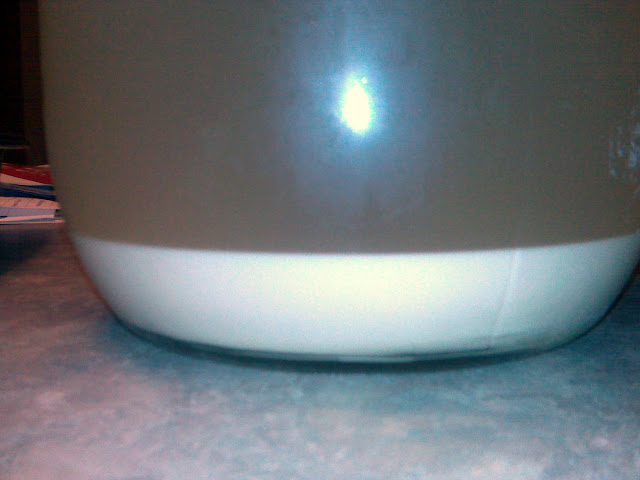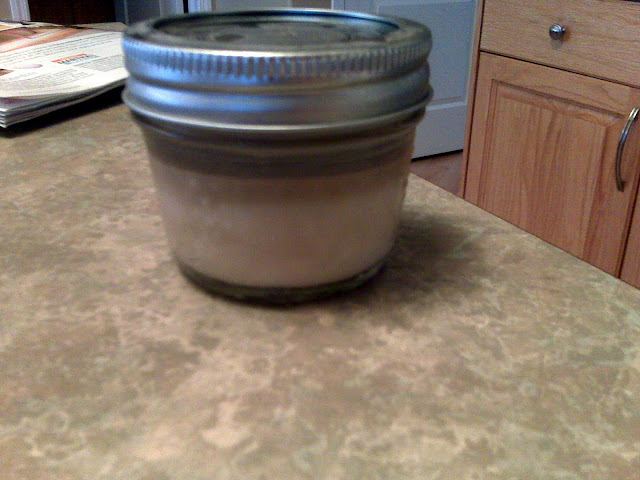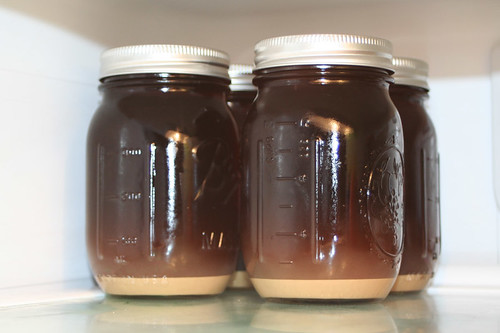You are using an out of date browser. It may not display this or other websites correctly.
You should upgrade or use an alternative browser.
You should upgrade or use an alternative browser.
Yeast Washing Illustrated
- Thread starter Bernie Brewer
- Start date

Help Support Homebrew Talk:
This site may earn a commission from merchant affiliate
links, including eBay, Amazon, and others.
Well I did this and all I got was more of the same. It almost seems like the yeast is stuck in white clumps like cheese curds and they sink to the bottom first. Does this make sense? Is the white stuff yeast and the brownish stuff not yeast?
It sounds like you need to shake it more vigorously to break up the clumps. The yeast is a very light cream color. Anything darker is spent yeast and/or trub and hops.
Well I guess my 1098 British Ale yeast has very high flocculation. It is not like the photos in this thread, it definitely sinks to the bottom first and makes a thick almost honey like consistency paste that sticks together quite aggressively.
I was able to pour the darker trub off of the top of it quite easily and I believe I'm left with mostly light colored yeast, and quite a bit of it actually. I guess we'll find out...I'll make a starter out of it to see how it does.
I was able to pour the darker trub off of the top of it quite easily and I believe I'm left with mostly light colored yeast, and quite a bit of it actually. I guess we'll find out...I'll make a starter out of it to see how it does.
Beer_Guy
Well-Known Member
My White Labs American Ale Blend was clumpy too. It seemed I would shake shake shake and still have clumps. I was able to salvage a lot of it by shaking and as soon as the yeast settled, pour off the dark liquid with the trub still floating. Did this a few times with fresh water until it was clean enough for me.
I haven’t tested the frozen stash yet, I hope it is good. After adding the glycol I shook the smaller bottles real good. I just trusted the Glycol got around the cells enough to prevent damage. Maybe next batch I’ll test it.
I haven’t tested the frozen stash yet, I hope it is good. After adding the glycol I shook the smaller bottles real good. I just trusted the Glycol got around the cells enough to prevent damage. Maybe next batch I’ll test it.
So here's what I was left with after pouring off the dark trub on top of the yeast.

With this I got 6 125ml jars that have about 75ml of good thick yeast in them (after settling) not including the small band of trub that is still on it.


With this I got 6 125ml jars that have about 75ml of good thick yeast in them (after settling) not including the small band of trub that is still on it.


$7.79 ($7.79 / Count)
Craft A Brew - LalBrew Voss™ - Kveik Ale Yeast - For Craft Lagers - Ingredients for Home Brewing - Beer Making Supplies - (1 Pack)
Craft a Brew

$172.35
2 Inch Tri Clamp Keg Manifold With Ball Lock Posts, Pressure Gauge, PRV (0-30 PSI) – Homebrew, Fermentation, Kegging System
wuhanshijiayangzhiyimaoyiyouxiangongsi

$58.16
HUIZHUGS Brewing Equipment Keg Ball Lock Faucet 30cm Reinforced Silicone Hose Secondary Fermentation Homebrew Kegging Brewing Equipment
xiangshuizhenzhanglingfengshop

$176.97
1pc Commercial Keg Manifold 2" Tri Clamp,Ball Lock Tapping Head,Pressure Gauge/Adjustable PRV for Kegging,Fermentation Control
hanhanbaihuoxiaoshoudian

$39.22 ($39.22 / Count)
Brewer's Best Home Brew Beer Ingredient Kit - 5 Gallon (Mexican Cerveza)
Amazon.com

$49.95 ($0.08 / Fl Oz)
$52.99 ($0.08 / Fl Oz)
Brewer's Best - 1073 - Home Brew Beer Ingredient Kit (5 gallon), (Blueberry Honey Ale) Golden
Amazon.com

$10.99 ($31.16 / Ounce)
Hornindal Kveik Yeast for Homebrewing - Mead, Cider, Wine, Beer - 10g Packet - Saccharomyces Cerevisiae - Sold by Shadowhive.com
Shadowhive

$53.24
1pc Hose Barb/MFL 1.5" Tri Clamp to Ball Lock Post Liquid Gas Homebrew Kegging Fermentation Parts Brewer Hardware SUS304(Liquid MFL)
yunchengshiyanhuqucuichendianzishangwuyouxiangongsi

$22.00 ($623.23 / Ounce)
AMZLMPKNTW Ball Lock Sample Faucet 30cm Reinforced Silicone Hose Secondary Fermentation Homebrew Kegging joyful
无为中南商贸有限公司

$53.24
1pc Hose Barb/MFL 1.5" Tri Clamp to Ball Lock Post Liquid Gas Homebrew Kegging Fermentation Parts Brewer Hardware SUS304(Liquid Hose Barb)
Guangshui Weilu You Trading Co., Ltd
platypotamus
Well-Known Member
I just followed these instructions a week or so back with some NW Ale yeast (Wy1332). Pretty simple procedure, and I ended up with 4 jars of washed yeast.

I already made a starter with one of them over the past weekend, and it took off like a rocket. I used it in for my Graff, and fermentation started within about 8 hours.
Many thanks to Bernie Brewer for the great walk-through!

I already made a starter with one of them over the past weekend, and it took off like a rocket. I used it in for my Graff, and fermentation started within about 8 hours.
Many thanks to Bernie Brewer for the great walk-through!
I proofed one with sugar and it came to life super fast. Looks like it worked!
Sugar bad. DME good.
Your yeast farming skills are complete, young Skywalker.I just followed these instructions a week or so back with some NW Ale yeast (Wy1332). Pretty simple procedure, and I ended up with 4 jars of washed yeast.

I already made a starter with one of them over the past weekend, and it took off like a rocket. I used it in for my Graff, and fermentation started within about 8 hours.
Many thanks to Bernie Brewer for the great walk-through!
Sugar bad. DME good.
Yeah I tossed it. I had 6 so I had enough to waste one on a test.
So I had a nice Pale Ale with WL 029 (Kolsch) yeast where I washed the yeast.
Unfortunately my jars don't look like they have as much yeast as the other photos I've seen on this thread, and I'm not sure why (or if it's even that bad). The two things I've thought of are that I have a Coopers fermenter and I just use the spigot on the side to get the water into the large jar after letting it settle, and I waited maybe 10 or 20 min longer to transfer between the different vessels.
Anyways, regardless of my technique, I'll keep trying, but I need to get an idea if I have enough of this yeast to use down the road. I have 1 pt jars, and they all have about the same amount of yeast.
Can anyone tell me from the photo below if it's enough to get a (2L) starter going? Or will I need to step it up? Or what?

Thanks for your help! And for the technique as well!
Unfortunately my jars don't look like they have as much yeast as the other photos I've seen on this thread, and I'm not sure why (or if it's even that bad). The two things I've thought of are that I have a Coopers fermenter and I just use the spigot on the side to get the water into the large jar after letting it settle, and I waited maybe 10 or 20 min longer to transfer between the different vessels.
Anyways, regardless of my technique, I'll keep trying, but I need to get an idea if I have enough of this yeast to use down the road. I have 1 pt jars, and they all have about the same amount of yeast.
Can anyone tell me from the photo below if it's enough to get a (2L) starter going? Or will I need to step it up? Or what?

Thanks for your help! And for the technique as well!
I would say you could get a 2L going with it but if it would make you feel more comfortable then go ahead and make a 1L and step it up 
Wingfan13
Well-Known Member
Quick question. I gave up looking after 12 or so pages. I noticed someone said you brew with the same yeast but does it matter what beer you brew ? You guys aren't brewing the exact same beers with the washed yeast. Just the brews that use the same type of yeast, correct ? Was that clear ? I have been drinking.
I made a hefe and washed the yeast and later used it to make a cider.
yes you are correct about just doing things that use the same type of yeast. (i realize that ciders dont always use the hefe types of yeast but it had properties i was looking for)
yes you are correct about just doing things that use the same type of yeast. (i realize that ciders dont always use the hefe types of yeast but it had properties i was looking for)
So I had a nice Pale Ale with WL 029 (Kolsch) yeast where I washed the yeast.
Unfortunately my jars don't look like they have as much yeast as the other photos I've seen on this thread, and I'm not sure why (or if it's even that bad).
Hey,
After my yeast was all clean I let it settle for a couple of days in the big jar. Then I poured of all of the liquid and added about 1 part of water to the 2 parts of yeast. Shook it all up and used a turkey baster to transfer the thick slurry into 125ml jars. Now they are about half full of yeast so I may have been a bit off on my 1:3 parts ratio, but no big deal.
But the main point is to let it pre-settle and then transfer it to smaller jars. My jars fit in the back of the fridge and they are pretty much unnoticeable. I used one for ed wort's apfelwein and it's going strong so 75ml of pure yeast was plenty.
BigB
Well-Known Member
Quick question. I gave up looking after 12 or so pages. I noticed someone said you brew with the same yeast but does it matter what beer you brew ? You guys aren't brewing the exact same beers with the washed yeast. Just the brews that use the same type of yeast, correct ? Was that clear ? I have been drinking.
You are washing the yeast simply to be able to reuse the yeast. Washing the yeast separates it from most of the trub so hopefully you have just yeast left. Which beer you use it in depends on what you want to brew. For example, say you washed a Wyeast 1028 London Ale that was used to ferment a Stout. You would reuse that yeast in any beer you would normally use the 1028 in. In other words, You CAN use it in anything, but why would you? It will have the same flavor, floccuation, and attenutation as the package of yeast you originally pitched.
AugustDerleth
Well-Known Member
Gammon, that's right. The amber colored fluid is the beer itself. The stuff on the bottom is the yeast that has settled out and separated from the beer. Like the FAQ said, you want to dump as much beer as you can without disturbing the yeast on the bottom (which isn't too hard). Then, when you have minimal liquid, your yeast slurry will be concentrated, which is just easier overall for the whole process.
Is that beer drinkable then? Definitely a stupid question, but I'm a newb! Thanks!:fro:
Jenks829
Well-Known Member
Is that beer drinkable then? Definitely a stupid question, but I'm a newb! Thanks!:fro:
It is! It is beer after all right?
Consider it a right of homebrewing passage to drink it. And then chew on a hop pellet to round out the experience!
BigB
Well-Known Member
It is! It is beer after all right?
Consider it a right of homebrewing passage to drink it. And then chew on a hop pellet to round out the experience!
Actually, If you refer to the post he quoted, he was questioning whether the amber colored liquid in the photo was beer. And the answer would be NO. It is simply water. The beer afterall was racked off the top. Then sterlie water was added to separate the trub from the yeast. That is all that remains- sterile water and yeast. Granted the water does take on a slight tint during the process, but it is by no sense, beer.
Sure you could drink it, but I imagine it wouldn't taste very good.
Actually it would be beer. (uncarbonated and watered down from the washing process) You do rack off the majority of it but there will still be some there which is how you are getting that amber color.
BigB
Well-Known Member
Actually it would be beer. (uncarbonated and watered down from the washing process) You do rack off the majority of it but there will still be some there which is how you are getting that amber color.
Beer would be a fermented beverage. I hardly think that because there is .000000000001% of diluted beer in the mixture that you could call that "beer." Take for example your bottles when you wash them out. If you empty the bottle out except for say an 1/8 inch layer over the settled yeast. Then refill the bottle with water. It would take on a tinted hue. Would you call that beer?

depends on how many i had before i did it

BigB
Well-Known Member
depends on how many i had before i did it
You got me there! I can't argue that. I will concede that by Coor's definition, that it would be beer!
elproducto
Well-Known Member
Fantastic Post, thanks OP.
Quick question, I'm about to bottle this weekend and would like to keep the US-05 from my primary using this method. If I were to brew a day or two after would I just pitch into a starter?
Quick question, I'm about to bottle this weekend and would like to keep the US-05 from my primary using this method. If I were to brew a day or two after would I just pitch into a starter?
Fantastic Post, thanks OP.
Quick question, I'm about to bottle this weekend and would like to keep the US-05 from my primary using this method. If I were to brew a day or two after would I just pitch into a starter?
Just bottle while you brew and put your new brew right on top of it
elproducto
Well-Known Member
Haha, I was thinking that. Not sure if I'm skilled enough, this will be my first bottling adventure. Not to mention I'm brewing Thunderstruck Pumpkin which looks quite labour intensive.
BigB
Well-Known Member
Haha, I was thinking that. Not sure if I'm skilled enough, this will be my first bottling adventure. Not to mention I'm brewing Thunderstruck Pumpkin which looks quite labour intensive.
US-05 is a dry strain and is pretty cheap, so IMHO it is not even worth washing. But, if you really want to reuse it, I would agree to just pitch on top of the old yeast cake. What you could do if you are concerned about this being your first bottling adventure, what I would suggest is this:
1. Brew your new beer.
2. As it is cooling, transfer the fermented beer into the sanitized bottling bucket and cover.
3. Pitch the new cooled wort onto the old yeast cake and put the fermenter away to let the yeast do its magic.
4. Go back to your bottling bucket and prime and bottle as directed in numerous threads on this site.
Or, make life easy on yourself. Go to the LHBS and get a pack of US-05 for $2.99 then brew and bottle on different days.
Brad
Well-Known Member
So out of those four mason jars would you use all four on your next batch or only one mason jar? Also would you make a yeast starter from the washed yeast before your next brew?
BigB
Well-Known Member
You would only use one unless you were brewing a beer with a really high OG. I am of the opinion that you should always make a starter when using liquid yeast. It wakes the yeast up, gives them a chance to multiply, and most importantly, it proves to you that your yeast is good.
A question that I've always had w/ this thread:
when I wash yeast using the directions in this thread, I keep the liquid that forms at the top (above the settled "trub")
when I make a liquid starter, I decant the liquid at the top and keep / use the "trub"
what gives?
when I wash yeast using the directions in this thread, I keep the liquid that forms at the top (above the settled "trub")
when I make a liquid starter, I decant the liquid at the top and keep / use the "trub"
what gives?
Similar threads
- Replies
- 36
- Views
- 2K
- Replies
- 149
- Views
- 15K
















![Craft A Brew - Safale BE-256 Yeast - Fermentis - Belgian Ale Dry Yeast - For Belgian & Strong Ales - Ingredients for Home Brewing - Beer Making Supplies - [3 Pack]](https://m.media-amazon.com/images/I/51bcKEwQmWL._SL500_.jpg)











